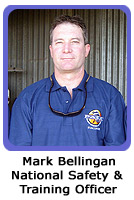Safety Line
By Mark Bellingan, D628
Freefly incident report:
The purpose of this short article
is to share one particular incident
report and to highlight the importance
of checks, systems and the small stuff.
Look after the small stuff and the
big stuff will, generally, look after
itself.
On a regular day, two super-current
and experienced skydivers arranged
a freefly skydive. Both skydivers have
a couple of sets of gear and are multi-skilled.
Skydiver A has over 12000 skydives
and is super-current, doing 1000 plus
skydives a year. He would be the coach
in the proposed skydive. Getting ready,
he was in a rush and opted for his
second set of gear as the other was
already set up for camera and he was
on a back-to-back load. The audible
in the second helmet had, at some time
earlier, indicated that the battery
was in need of replacement as it was
warning/ beeping at a higher altitude
than it was set for, but he opted to
use it anyway, thinking it should be
OK for one more jump!.
Skydiver
B is just short of 2000 skydives
and is also super-current having
done almost 1000 skydives in the
last year. Skydiver B also used his
second set of gear and for whatever
reason had forgotten or neglected
to turn his second audible on at
the time that he got his gear ready
for the day and didn’t check it’s
operation on the way up to altitude
Prior to
exit, skydiver A told skydiver B
that his audible had turned off and
that they would rely on B’s audible
and that B should give a clear indication
at the 5000ft pre-set warning altitude.
B verbally confirmed this with A.
The skydive was of a freefly nature
and required some very hard flying
which presented some difficulty in
reading altimeters so they both, independently
of each other, decided to trust their
audibles and use each other as backup.
Just prior to exit, this was reduced
to one audible.
The skydive
was uneventful for the first half
but started to get a bit messy in
the second half which required more
concentration and input…
At 2000ft,
skydiver A’s internal
clock alerted him to the fact that
this had been going on too long and
so he looked at the ground behind skydiver
B, realized he was low, flattened out
and deployed.
Skydiver B observed the deployment,
flattened out and deployed his main
parachute, approximately one second
later. His parachute inflated fully,
he turned 90 degrees and checked his
altimeter. It read 100ft.
Both these skydivers are extremely
current and are consistently open at
a safe altitude on every jump as indicated
on their digital/ audible altimeters.
Going low is not an option for them.
It is noted
that both skydivers did not have
an automatic activation device (AAD).
Safety & Training highly
recommends the use of an AAD for all
skydivers.
- Don’t
think that this could not happen
to you.
- Have a pre-jump and gear check
system that you stick to.
- Turn all
your electronic gear on at the
same time – AAD, altimeter,
audible etc.
- Do not try and milk the last milliamp
out of the batteries.
- If something changes re-evaluate
the whole dive plan.
